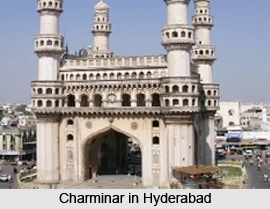 The monuments of Hyderabad continue to tell the tale of the glory and grandeur of the Nizams of Hyderabad, the rulers of the largest states in India. For generations a small Muslim minority ruled a predominantly Hindu population with guile and skill on British advice. The plans of the city of Hyderabad were made when the stars and astrological indicators were most positive. It was intended as a replica of Paradise itself and accordingly the monuments of Hyderabad echo this intent in their construction and architecture and figure as a top draw where the monuments of Andhra Pradesh are contained.
The monuments of Hyderabad continue to tell the tale of the glory and grandeur of the Nizams of Hyderabad, the rulers of the largest states in India. For generations a small Muslim minority ruled a predominantly Hindu population with guile and skill on British advice. The plans of the city of Hyderabad were made when the stars and astrological indicators were most positive. It was intended as a replica of Paradise itself and accordingly the monuments of Hyderabad echo this intent in their construction and architecture and figure as a top draw where the monuments of Andhra Pradesh are contained.
Hyderabad was founded Muhammad Quli Qutab Shah, the fifth ruler of Golconda from the Qutab Shahi dynasty, in 1591. It is alleged that the city is named after a mistress of Quli Qutab Shah and Hyder Mahal. The layout of the city has been set along a grid pattern with two main roads running north-south and east-west, at the intersection of which is the Char Minar, one of the most prominent landmarks of Hyderabad.
The Musi River lay to the North, to the south the Kohi-Tur Hill, due west was the fortress of Golconda and east the road to the coast. The city expanded to the east and on this road is the Dargah Hazrat Brahna Shah Sahab, one of the oldest graveyards of Shia sect of Islam. Around the Char Minar, Muhammad Quli Qutab Shah built his royal palaces, with carved sandalwood details. These were destroyed during the conquest of 1687 by rulers of the Mughal dynasty.
A cosmopolitan inclination was always inherent in the city with Persian and Armenian merchants vying for space with the local Hindu and Muslim traders. It was under Mubaiz Khan, the Mughal governor, that the work of setting up the city was started. It was completed in 1740 and at one time it had fourteen gates and four posterns. However, few sections now remain. Of the gateways only the Dabirpura Darwaza and the Purana Pol Darwaza have survived, the latter on the road from Char Minar to Golconda.They were destroyed partly as the city expanded and partly in the disastrous flooding of 1908.
Hyderabad is currently the fifth largest city in India. At the time of Indian independence in 1947, Hyderabad declared itself independent and only acceded to union with India when invaded by Indian government troops.
Hyderabad has been an important centre of Islamic culture. The architecture of the various monuments is a beautiful legacy of a grand Empire. A number of monuments, both historical and religious, are found in Hyderabad.



















